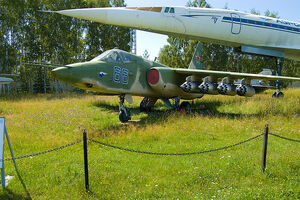| Sukhoi Su-25 Frogfoot | ||
|---|---|---|

| ||
| Description | ||
| Role | Ground-attack aircraft | |
| Crew | 1 pilot | |
| Passengers | ||
| First flight | 22nd February 1975 | |
| Entered service | 1981 | |
| Manufacturer | Sukhoi | |
| Produced | 1,024 | |
| Dimensions | ||
| Length | 15.36 m | |
| Wingspan | 14.36 m | |
| Height | 5.20 m | |
| Wing area | 30.10 m² | |
| Weights | ||
| Empty | 9,315 kg | |
| Loaded | ||
| Maximum takeoff | 17,600 kg | |
| Powerplant | ||
| Engine | 2 × Tumanski R-95Sh | |
| Power (each) | 40.17 kN | |
| Performance | ||
| Maximum speed | 975 km/h | |
| Cruising speed | ||
| Range | 1,950 km | |
| Ceiling | 7,000 m | |
| Rate of climb | ||
The Sukhoi Su-25 Frogfoot is an single seat, twin engine, Soviet attack aircraft developed by Sukhoi. Its main role is close air support.
History[]
Development of the Su-25 began in the early 1960s, following discussions on the need for a new ground attack aircraft.[N 1] In March 1969 the Ministry of Air Industry issued official proposals to four construction bureaux - Ilyushin, Mikoyan, Sukhoi and Yakovlev.[1]
The development team at Sukhoi was led by Shuri W. Iwashetshkin and they submitted a private venture prototype designated T-8, completed in 1974, making its first flight on 22 February 1975 in the hands of Wladimir Ilyushin, who flew the first prototype (T-8-1) in Zhukovsky, which was equipped with RD-9 engines, producing a thrust of 25.5 kN each. This was followed by the T-8-2, a modified second prototype (greater wingspan and modified flaps and stabs), which had its first flight on 26th December 1975, flown by W. P. Walsilyev. Both prototypes were equipped with new R-13-300 engines. But on the definitive aircraft R-95Sch engines were used, producing a thrust of 40.17 kN. Those were built in Tbilis (Georgia), in this factory the series production began in 1978, and the first flight of the T-8-3 aircraft was in 1979. Although the design did not comply with the thinking of the time, the T-8 won the competition, despite needing continued development before it could enter front line service. Sukhoi's desire to test the T-8 under combat conditions resulted in two prototypes - T-8-3 and the modified T-8-1 - being used from April to June 1980 on 44 missions in Afghanistan.
The Su-25 competed with the Ilyushin Il-102, and prevailed itself and was ordered by the Soviet Air Force.
After NATO identified the Su-25 in the year 1977, it was provisionally named Ramenskoje Ram-J. It received the nickname Frogfoot in the year 1981.
References[]
Notes[]
- ↑ The discussions were prompted by the emergence of new data from localised conflicts, such as the ones in South East Asia, the WarPac67 exercise, analysis of the USAF A-X project (which led to the A-10 Thunderbolt II) and the need for improved survivability and resistance to damage.
Sources[]
- ↑ World Aircraft Information Files Aviation Partwork. Midsummer Books Ltd. File 269 Sheet 1 (World Military Aircraft:Sukhoi Su-25 'Frogfoot' - Introduction')